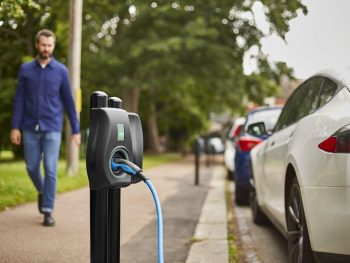Concerns for on-street charging as new report reveals holes in council EV approaches
Total charger coverage for UK ‘on-street’ households has increased significantly in the last two years but growth has not been consistent across the UK and there are concerns about charging inequality.

Total charger coverage, the percentage of all on-street households that are within five minutes’ walk of a public charger, has increased by 42%, from 12% to 17%
That’s according to a new report now out from net zero data consultancy Field Dynamics, which says some councils are getting charging provision right, some are getting it “expensively wrong”.
Carried out in partnership with Zap-Map, the new report follows the company’s inaugural study into the importance of understanding the distribution of charging for ‘on-street’ households – those who do not have access to charging off-street – which it says account for 35% of all households in Great Britain, equating to some 9.8 million.
The new variance report shows that the EV market has changed significantly since the first analysis – published autumn 2020 – with significant investment in infrastructure and an increase of EVs on the roads.
Latest data provided by Zap-Map shows that total charger coverage, the percentage of all on-street households that are within five minutes’ walk of a public charger, has increased by 42%, from 12% to 17%.
But coverage is still inconsistent, with London Boroughs achieving an average of nearly 60% coverage while Metropolitan councils average less than 14%.
Increases in coverage are very inconsistent too, with limited evidence of any contributing trends. As an example, for those 225 councils that provided 10% or less coverage in 2020, the increases range from 0% additional coverage to 24%.
The data also reveals that EV adoption in general has rocketed, with 293 councils seeing an average of 50% increase in residential chargers across the same period.
The research is intended to provide the basis for objective observations on UK public charging infrastructure.
Field Dynamics Managing Director Ben Allan said: “In an ideal world, all residents would benefit equally from investments in on-street chargers. So, as the number of chargers increased, the coverage would increase by the same amount. Yet this is not what’s demonstrated in the latest study.”
But the firm noted that siting and delivery of EV chargers is a complex matter, with many conflicting requirements all combining to create an impossible task.
Allan explained: “We therefore look at the differences between councils in our data as reference points, not judgments on which council is right and which is wrong.
“We also recognise that the market is still very immature and without mainstream behaviours and data, the right approach can only be inferred.
“However, the clear summary of this report is that firstly there is little consistency in approach and outcome. Secondly, there is little correlation between demand and investment. And thirdly there is little standardisation between council types. This inherently means that while some are getting it right, many are getting it expensively wrong and will carry on doing so for some time.”
An interactive map of the results can be found here, more details of the study including a report are here.












